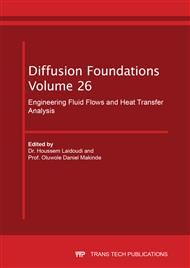p.23
p.39
p.53
p.63
p.78
p.86
p.104
p.112
p.126
Effects of Inlet and Outlet Ports of Ventilated Square Cavity on Flow and Heat Transfer
Abstract:
This paper deals with numerical simulations of forced convection from a pair of identical cylinders arranged in tandem manner inside a square cavity of single inlet and outlet ports. The gap distance between the cylinders is fixed with half of square length. The main purpose of this study is to see the effect of inlet and outlet port positions on fluid flow and heat transfer rate. The governing equations of continuity, momentum and energy have been solved using finite-volume method in laminar, steady and two dimensional directions. The work has been done in the range of these conditions: Re = 1 to 40, at fixed Pr = 7.01. Three positions of inlet and outlet port have been selected. The mean results of flow patterns and distribution temperature are illustrated under the contours of streamline and isotherm respectively. The drag and lift coefficients of each cylinder is computed and discussed. The average Nusselt number of both cylinders is also presented and discussed. It was found that the inlet and outlet ports have significant effects on heat transfer from the confined cylinders.
Info:
Periodical:
Pages:
78-85
Citation:
Online since:
March 2020
Keywords:
Price:
Сopyright:
© 2020 Trans Tech Publications Ltd. All Rights Reserved
Share:
Citation:


